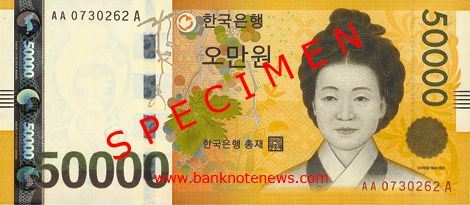South Koreans frustrated by 50,000-won notes
20 11, 2009 12:22 Category: East and Southeast Asia


According to a Korea Times article dated 11-10-2009, some South Koreans have difficulty distinguishing between the new 50,000-won (US$43.20) note and the old 5,000-won (US$4.30) note due to “their physical similarity” and are calling for the government to change the color of the highest-value banknotes.
The Bank of Korea, however, says no countermeasures are being considered at this time, adding there are several identification devices applied to the bills: The 50,000-won bills are longer than 5,000-won notes by 12 millimeters, and a hologram on their surface is easily noticeable in dark places. "Such criticism is somewhat groundless because U.S. dollar bills are issued all in the same color but not subject to such confusion," a BOK official said on condition of anonymity. "The two bills are different in color, as 50,000-won bills are yellow and 5,000-won bills are reddish-yellow."
It’s hard to imagine how anyone can confuse the two notes since they are of clearly different colors, feature very different portraits, and have easily distinguishable security threads and holographic elements. However, I gave some thought to the BOK official’s defense that the US dollar isn’t subject to confusion. Perhaps it is precisely because the US notes are all the same size and approximate color that the public is forced to pay particular attention to their printed denominations.
In this case, the US benefits from a limited number of denominations, all of which can be expressed by one, two, or three easily distinguished digits: 1, 2, 5, 10, 20, 50, and 100. When looking at the 5,000- and 50,000-won notes, you see that it’s not easy to know the denomination at a glance because you must stop to count the zeros. An easy fix to this problem would be to use a space-holder character such as a comma, or make the last three zeros shorter than the other digits so that the 5 and 50 would stand out.

